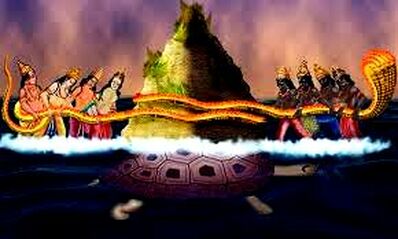|
Samundra Manthan during journey of life The mythological episode of Samundra Mandhan (Ksheera Sagara Manthan or Sagar Manthan) or Churning of ocean is mentioned in Bhagavata Purana, in the Mahabharata and in the Vishnu Purana. The story is about churning of ocean by Devas and Asuras in search of Amrita or nectar of immortality. Tales of in Vedas, Puranas and other Hindu religious books have always tried to teach man some profound principles in life symbolically. This story gives us a good description of how our nature works. Every human being is influenced by positive and negative tendencies. Effective balancing of the positive & negative tendencies and harmonizing both these energies attain salvation and true bliss in this lifetime. When milk is churned, butter becomes separated from the milk. In the material world, one achieves positions and wealth during the life journey. But those who aspire for bliss initially get Halahala (Poison, sufferings) and if they conquer it and further are not swayed away by powers, wealth & successes, get ultimate bliss. In spiritual journey, butter is sattva and mental brilliance or pure intelligence. As by heating process at medium or low temperature, butter converts into Ghee, likewise by practice of austerities like deep meditation, self-control & discipline and other spiritual practices, the practitioner experiences supernormal vision and bliss. The episode symbolically explains various stages of elevation of Human Being –
The mythological episode and the spiritual concept are explained as under: The mythological episode:
The episode symbolically represents the forces working within human beings.
0 Comments
Leave a Reply. |
Archives
May 2024
Categories |

 RSS Feed
RSS Feed